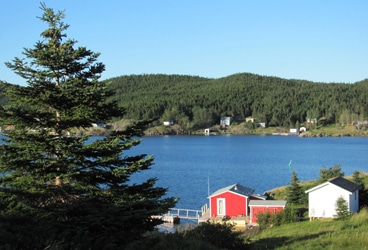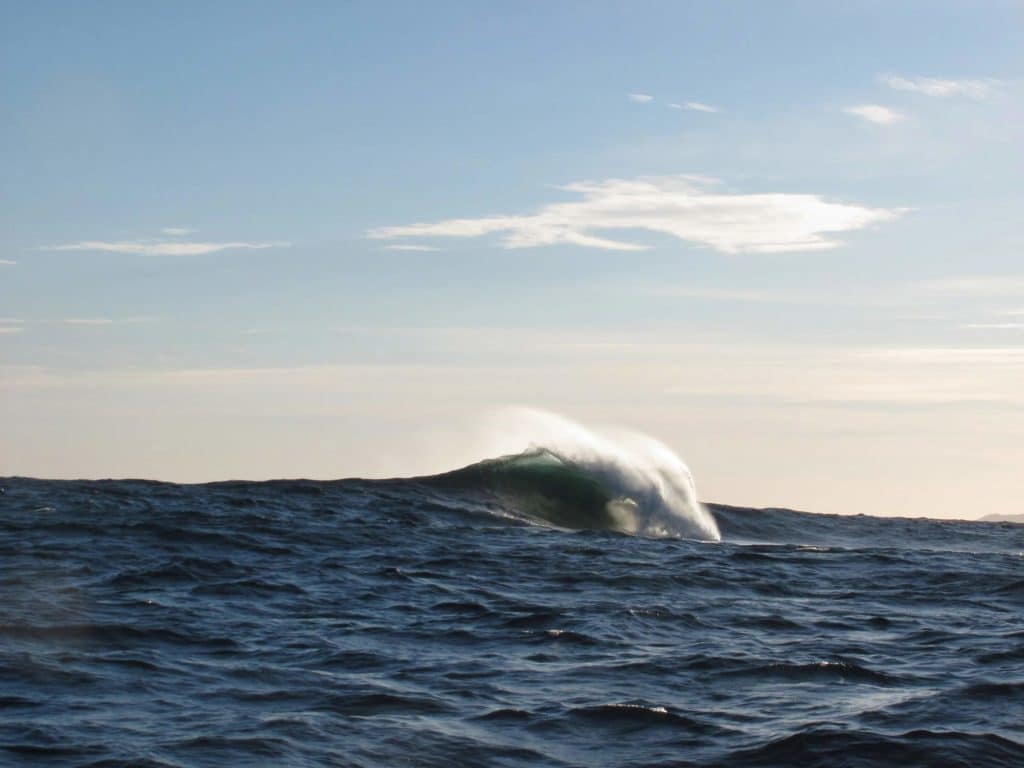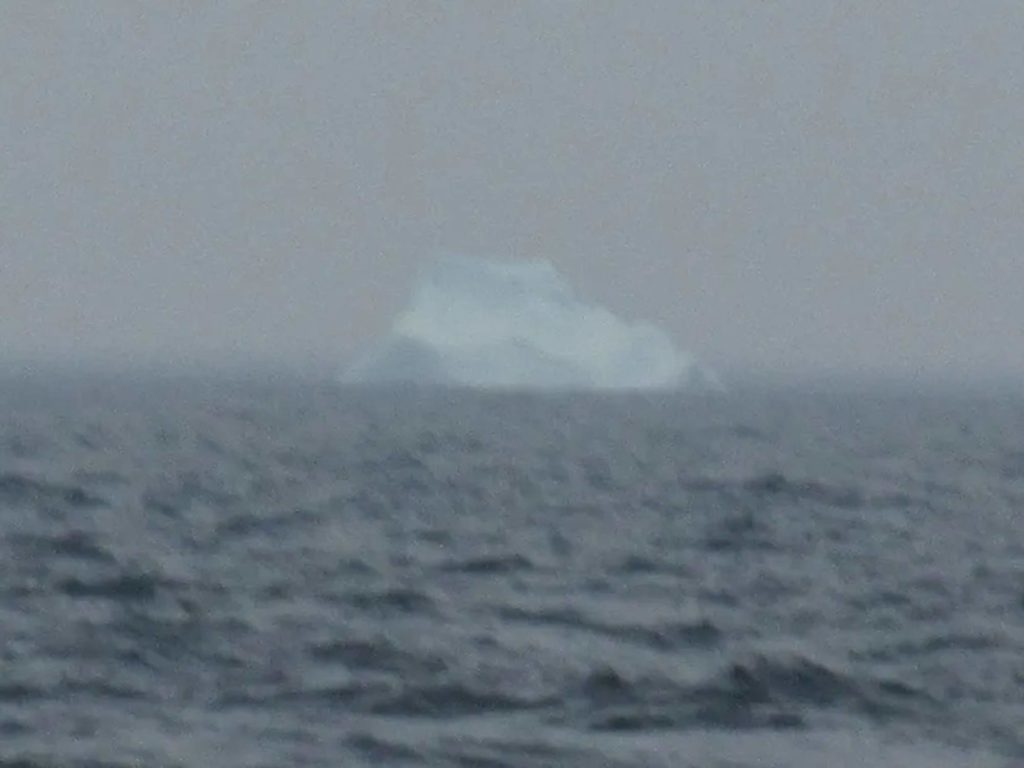
We were talking about Labrador, a local and I, and I asked him whether a place was further up along the coast than Red Bay. “No,” he said, giving me a funny look. “There’s not much further UP from Red Bay—everything’s down to the North from there.” I remembered reading, somewhere long ago, that along this coast they refer to North as “Down”, as if descending into further cold and danger, and South as “Up.” Up toward the light and warmth and greenery; up to where life is easier. But it was still surprising to encounter it the first couple of times, and I’m still getting used to telling folk that we’re heading north, “Down toward Labrador.”
Our departure from Twilingate was a little difficult—there was still a stiff wind blowing from the north, but since we wanted to get a few miles southward into Notre Dame Bay, we thought the struggle north for three miles until we could turn the corner at Long Point would be worthwhile. And it was, once we had made it, but it was a frightful slog against not just the wind but a huge swell that only got bigger and steeper the further we got from the harbor. It may have been the worst rolling we ever got in Ganymede—without a sail up to steady her, she rolled repeatedly gunnel to gunnel, and the tubs of water I’d filled for washing dishes later got completely sloshed out. Mostly on my trousers, but enough on Danielle’s too that we could be miserable in company.
Exploits
But we turned the corner at long last, and had a delicious sail down—er, up into Notre Dame Bay. The next day it would have been impossible, since it was to blow 20-25 from the SW. It had been late in the day when we left Twilingate, and it was nearly evening when we tied Ganymede up to an empty wharf at Exploits Island. There was still good time for a walk on shore among lonely cabins overgrown with berry bushes. The contrast from the dirty bustle of Twilingate made it seem all the more quiet and peaceful and altogether wonderful.

In spite of the restfulness of it, we left early the next morning—we had one day to find a good haven before the next SW gale was to arrive, and Upper Exploits harbor was wide open to the south. We had a mere ten miles to go to Fortune harbor, but it was hard enough to do. The swell coming up from the North was still wicked, making some spectacular and horrifying breakers on the shoreline and offlying shoals, and the wind was being accelerated in its usual way off the high cliffy hills surrounding Fortune Harbor. It seemed almost a miracle, once we fought slowly into the harbor entrance, how the wind dropped to almost nothing, and then to actually calm the further in we went. I could hardly believe that barely half an hour before I had had to get the double-reefed sail in as quick as possible before the rail could start scooping foaming water. But there was the mainsail, bundled untidily to the gaff, and all the halyards festooned any old way to testify to a harrowing entry.
We were sounding about looking for a likely anchoring spot when a voice from shore hailed to invite us to a mooring near the shore. Ah, Newfoundland! Not only did we get a mooring for free, but were offered filtered, UV-disinfected water; tasteless, colorless, odorless water! Gleefully we filled all our empty jugs and debated whether to dump out all the smelly yellow stuff from Bonavista. We decided in the end not to abuse our benefactor’s hospitality—it had to cost something to filter and purify all that water, and the bad water would do for sponge baths and dishwashing in future gurry-filled ports.
When we arrived in La Scie several days later, they were still shellshocked from the gale, but in Fortune we hardly felt it—not because it hadn’t blown there, but because we were in the best possible spot to ride it out. It’s worse to ride out bad weather pinned against a dock than at a mooring or at anchor where the bows can always be into the wind and the companionway faces properly downwind—it’s how boats are designed to handle weather, and that gale was the easiest time we ever had in one.
It was a gray sort of day when we left Fortune to cross Notre Dame Bay to Cape St John—an uneventful day, mostly, except when a darker patch of cloud passed somberly overhead and made the wind shift five times in as many minutes. It’s a pity the wind was so fickle and the sky so fretful, or we might have changed course to get closer to our first iceberg. As things were, we felt there was not a moment to lose in getting to La Scie, so we took photos from afar (how far? No telling—distances to icebergs are hard to judge on muzzy days) but carried doggedly on.

It was good that we did, for just as we were off of Cape John the wind began to blow briskly off of it. If we’d been longer in getting there, we might have had more difficulty rounding it. As it was, we had to get all canvas in pretty quick, and soon after there was a gust or two so strong it picked up bits of spray and sent them downwind in little whirlwinds. It was a long five miles to La Scie against that wind, but we made it in at last, only to have the hardest time ever trying to tie up to a wharf. The wind was constantly changing direction as it shotgun-blasted around the hills, and even if I charged head-on at the wharf and turned at the last minute, I couldn’t get Ganymede closer than ten feet off. Danielle refused even my urgent suggestions that she should try and jump the gap anyway with a spring-line.
At last a scimitar-like swoop got the stern in close enough for me to leave the engine and leap ashore with a stern line, which is the least useful scenario, but we weren’t being picky. Before all was said and done, we had spent a few minutes moored stern-first, with the bowsprit waving bravely into the fairway and the transom pushed hard against the wharf. Finally Ganymede lay decently alongside and we could see what there was to see in La Scie, the latest stop of our trip down north.








